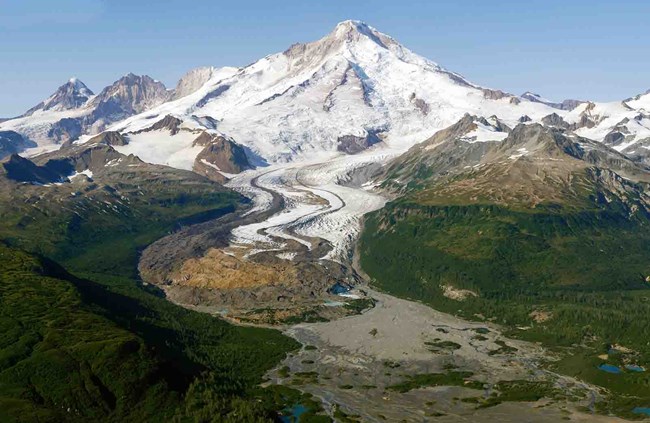
NPS/Buck Mangipane
Climate
Lake Clark National Park and Preserve is divided by the Chigmit Mountains, which separate the subpolar marine climate of Cook Inlet from the continental climate of Interior Alaska. The coastal east side of the mountains is typically warmer and wetter than the west side. Port Alsworth, located west of the Chigmit Mountains, represents inland climatic conditions.
Geology
The Chigmit Mountains are composed of a complex of multiple granitic stocks and batholiths that intruded after Triassic time into Paleozoic and Cenozoic rocks. The main batholith is elongated to the northeast, parallel to the structural trends of the region. The intruded rocks, which dip away from the Chigmits, are moderately to highly deformed volcanic and sedimentary rocks. Three volcanic piles of Tertiary to Recent age are still active: Mount Spurr, Redoubt Volcano, and Iliamna Volcano.
The park has been extensively glaciated, with three known advances. All glacial deposits appear to be of Wisconsin age or younger. Glacial ice, much of it associated with Redoubt and Iliamna volcanoes, covers approximately 30% of the park. Like all parks in Alaska, glacier cover in Lake Clark has declined over the last 50 years. Silty meltwater from these glaciers and associated snowfields strongly influences the hydrologic cycle in the park.
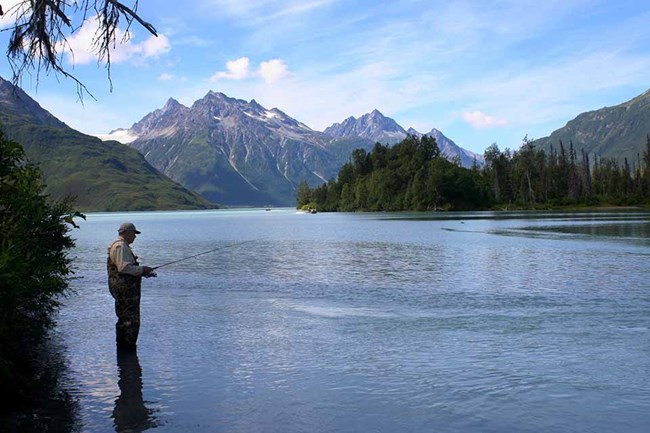
NPS/Megan Richotte
Hydrology
Lake Clark National Park and Preserve contains more than 6,000 miles of rivers and streams—some of the most diverse water resources in the National Park System. The Alaska and Aleutian mountain ranges form a continuous watershed divide separating the coast from the interior.
The headwaters for five major drainage basins are located within the park boundaries: the Kvichak River, Nushagak River, Kuskokwim River, Chakachatna River, and Coastal basins. Lake Clark National Park and Preserve also includes the sixth-largest lake in Alaska, Lake Clark, and three river segments designated as Wild Rivers: Chilikadrotna (11 mi), Mulchatna (24 mi), and Tlikakila (51 mi).
Coastal and Marine Resources
Lake Clark contains 130 mi (209 km) of coastline in western lower Cook Inlet, an extremely dynamic, high-energy estuarine environment. The normal tidal cycle has an average height ranging from about 18 ft (5.5 m) in Kachemak Bay to 29 ft (8.8 m) at Anchorage. Extreme high tides can be in excess of 36 ft (11 m), making the tidal ranges in Cook Inlet among the largest in the world.
The rivers emptying into Cook Inlet carry very high loads of suspended sediments, mainly fine glacial flour. Forty-three percent of the coastline is protected from high-energy waves. Salt marsh accounts for 22% of the total shoreline length and 42% of the total intertidal area. The combined soft substrates (salt marsh, sand, and mud flats) account for 90% of the total coastline length and 98% of the total area. Combinations of rocky shores (ramps, platforms, cliffs) are a very small percentage of the total habitat type on the coastline.
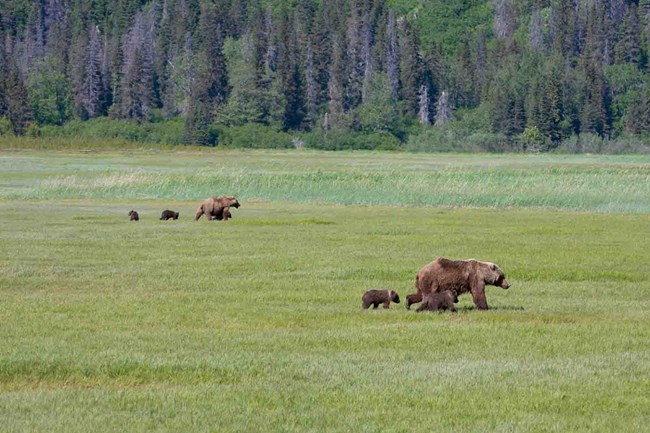
NPS/Kevyn Jalone
Flora and Fauna
The Cook Inlet coast supports extensive salt marshes in Tuxedni and Chinitna Bay and scattered marshes and lagoons elsewhere along the Lake Clark coastline. The sedge meadows, dominated by Ramensk’s sedge and salt-tolerant forbs, provide early season forage for brown bears. Much of the coast has experienced tectonic uplift, particularly following the 1964 earthquake, and narrow bands of white and/or Lutz spruce have established on beach berms and in the upper meadows. The depositional flats and lower mountainsides behind the beaches are covered with spruce forests and alder thickets. Conifer forests have multi-aged trees with thick moss understory, devil’s club, salmonberry, and scattered alder. Scattered stands of spruce rise out of extensive stands of alder, especially around the Tuxedni coast and above the dense spruce forest. Alder thickets grow above the spruce zone, thinning out into bluejoint meadows at the upper limits. The alpine tundra zone is very narrow on the coastal side of the mountains, dominated by partridgefoot, crowberry, and forbs.
The center of the park is primarily glacial ice and bedrock or till. Most valley glaciers are in retreat, leaving large expanses of moraines and ground till, which are slowly revegetating with mosses and lichens, fireweed and Dryas, willow and alder. An ecosystem of note is the expansive shallow wetlands along the Neacola River, which runs into Chakachamna Lake. The valley provides rich habitat for beaver, moose, nesting waterfowl, and bear. The wetlands appear to be dominated by sedges and willows, and are maintained by flooding and beaver activity.
The western side of the park is dominated by a series of large long lakes with their eastern extents in the Alaska Range and their western edge bounded by terminal moraines from the most recent advances of large valley glaciers. Low ridges and subdued mountains lie between the lake systems. The northern part of the park, by the Stony River, is boreal in character, with black spruce, muskeg, aspen and birch, and subject to wildfire. Further south, vegetation is a mosaic of spruce and mixed spruce/birch or cottonwood forests, paper birch, low shrubs dominated by dwarf birch, dwarf shrub tundra with ericaceous shrubs, scattered wetlands, and alpine tundra. Vegetation patterns are arrayed in response to soil texture and drainage patterns from a complex glacial and alluvial history.
Intertidal sand flats in some locations support dense populations of bivalves, including razor, littleneck, and soft-shell clams. Intertidal mud flats in Chinitna and Tuxedni bays support large to moderate standing crops of suspension- and deposit- feeding invertebrates. Eighteen species of Polychaeta, 7 species of Mollusca and 12 species of Crustacea have been identified in Chinitna Bay. The trophic relationship between shorebirds, sea ducks, diving ducks, and pink clams may be the most significant near-coastal predator-prey linkage along the Lake Clark-Cook Inlet coastline.

NPS/Dan Young
Forty-six species of fish are listed as present or probably present in the park. In marine waters, small pelagic schooling fish, including capelin, sand lance, eulachon, and Pacific herring, occur in nearshore and estuarine waters, while halibut and gray cod are found offshore. Dominant species during summer in Tuxedni Bay include juvenile pollock, sand lance, osmerids, and herring.
Sockeye salmon are a keystone species in the aquatic and terrestrial ecosystems. Nutrients from spawned-out salmon carcasses play a crucial role in sustaining the productivity of riparian and lacustrine ecosystems, including the perpetuation of future salmon runs. Sculpin, least cisco, lake trout, rainbow trout, and burbot all derive nutrients from sockeye salmon in one form or another. Salmon influence the seasonal distribution and abundance of birds and mammals that prey on them. In the interior of the park and preserve, Bald Eagles are associated with river-lake systems that support salmon. Bears depend on abundant salmon to bolster fat reserves vital to survival during hibernation. Because much of Lake Clark remains ice-free until February, salmon carcasses support overwintering Bald Eagles and are an important food resource for an array of vertebrate predators and scavengers, including wolves, coyotes, red fox, wolverine, and lynx.
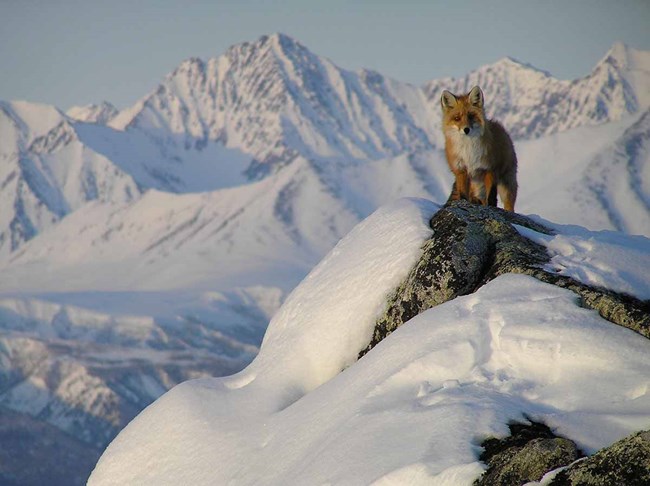
NPS/J. Mills
Thirty-six species of terrestrial mammals are documented or expected to occur within the park. Moose occur throughout, but due to deep snow, are less common on the coast. Dall’s sheep reach the southern extent of their range and occur along the western slopes of the Chigmit Mountains on the common boundary of the park. The Mulchatna caribou herd calves adjacent to the western boundary of the preserve and ranges through the foothill lakes and tundra plains of the western preserve. This herd is one of the most important for local subsistence and nonlocal Alaska hunters and heavily supports Alaska’s guide and transporter industry. Brown bears, common in all habitats, are most numerous along the coast, where an estimated 180-230 bears graze in salt marshes during the summer.
Black bears use all areas of the park except the higher elevations. Other terrestrial mammals—wolves, lynx, coyotes, and wolverines—range widely throughout the forests and low alpine areas, also populated with porcupines and snowshoe hares. Hoary marmots, Arctic ground squirrels, and pikas occur in alpine meadows and boulder fields. Twelve species of vole, lemming, and shrew probably occur, of which the redback vole is most abundant. Mink, beaver, and river otter inhabit ponds, lakes, and rivers. River otters are particularly common along the coast. Red squirrel, American marten, short-tail weasel, and least weasel are also found throughout the park and preserve.
Harbor seals haul out at three sites (Tuxedni Bay, Chinitna Bay, and Johnson River) and pup near the mouth of the Tuxedni River. Beluga whales seasonally occur off the mouths of glacial rivers in both bays and are most numerous during August and September. Sea otters occasionally stray into park waters, but are more common in the waters south of the park.
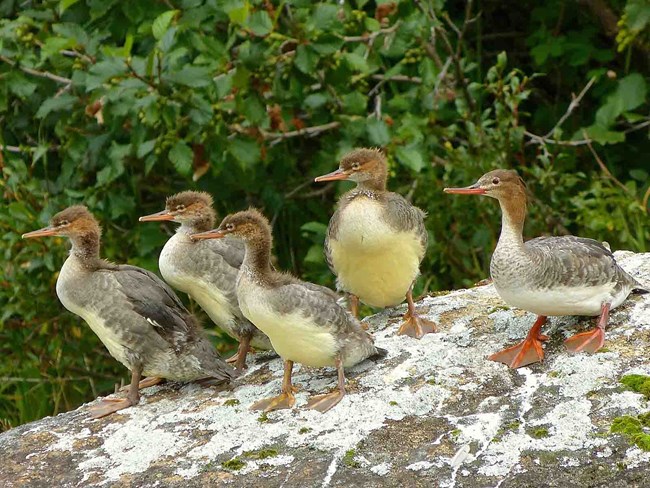
NPS/J. Mills
One-hundred-eighty-nine species of birds are documented or expected to occur in the park and preserve. Of these, 70 are landbirds, and many are neotropical migrants. Raptors, including Bald Eagle, Golden Eagle, Northern Goshawk, Sharp-shinned Hawk, Northern Harrier, and Merlin, breed in the area. Both Bald Eagles and Golden Eagles are known to nest in the park, as well as Osprey. Peregrine Falcons occupy eyries on cliffs along interior lakes and rivers, and at Tuxedni Bay.
Waterfowl nest and molt in wetlands throughout the area. Large migratory flocks of ducks, swans, and geese rest and feed in the park and preserve before flying from Nikabuna Lakes to Lake Clark through low mountain passes in the Chulitna River drainage. Sea ducks, primarily White-winged Scoters and Surf Scoters, are the most abundant waterfowl on the coast, numbering more than 18,000 in mid-August. About 30 pairs of Trumpeter Swans nest in the park, the farthest-west breeding population. Canada Geese occur in Tuxedni Bay and can number about 4,400 during fall migration.
Seabird breeding colonies occur along Cook Inlet and concentrate at Tuxedni and Chinitna Bays. Of the seven seabird colonies surveyed from 1994 to 1996, the largest contained 2,700 Black-legged Kittiwakes. During spring migration, 86,000 to 122,000 shorebirds, primarily Western Sandpipers and Dunlin, use intertidal mud flats in Tuxedni and Chinitna bays. Rock Sandpipers, designated as a “Species of Moderate Concern,” winter in Tuxedni Bay, an International Reserve in the Western Hemisphere Shorebird Reserve Network.
Federal species of concern that occur in terrestrial areas of Lake Clark include the Harlequin Duck, Olive-sided Flycatcher, and lynx. American Peregrine Falcon, Olive-sided Flycatcher, Gray-cheeked Thrush, Townsend’s Warbler, and Blackpoll Warbler are State of Alaska species of special concern that have been documented or are expected to occur in the park.
What's Happening in Lake Clark National Park and Preserve
Last updated: February 2, 2022
